2023 TOYOTA 4RUNNER child lock
[x] Cancel search: child lockPage 141 of 608
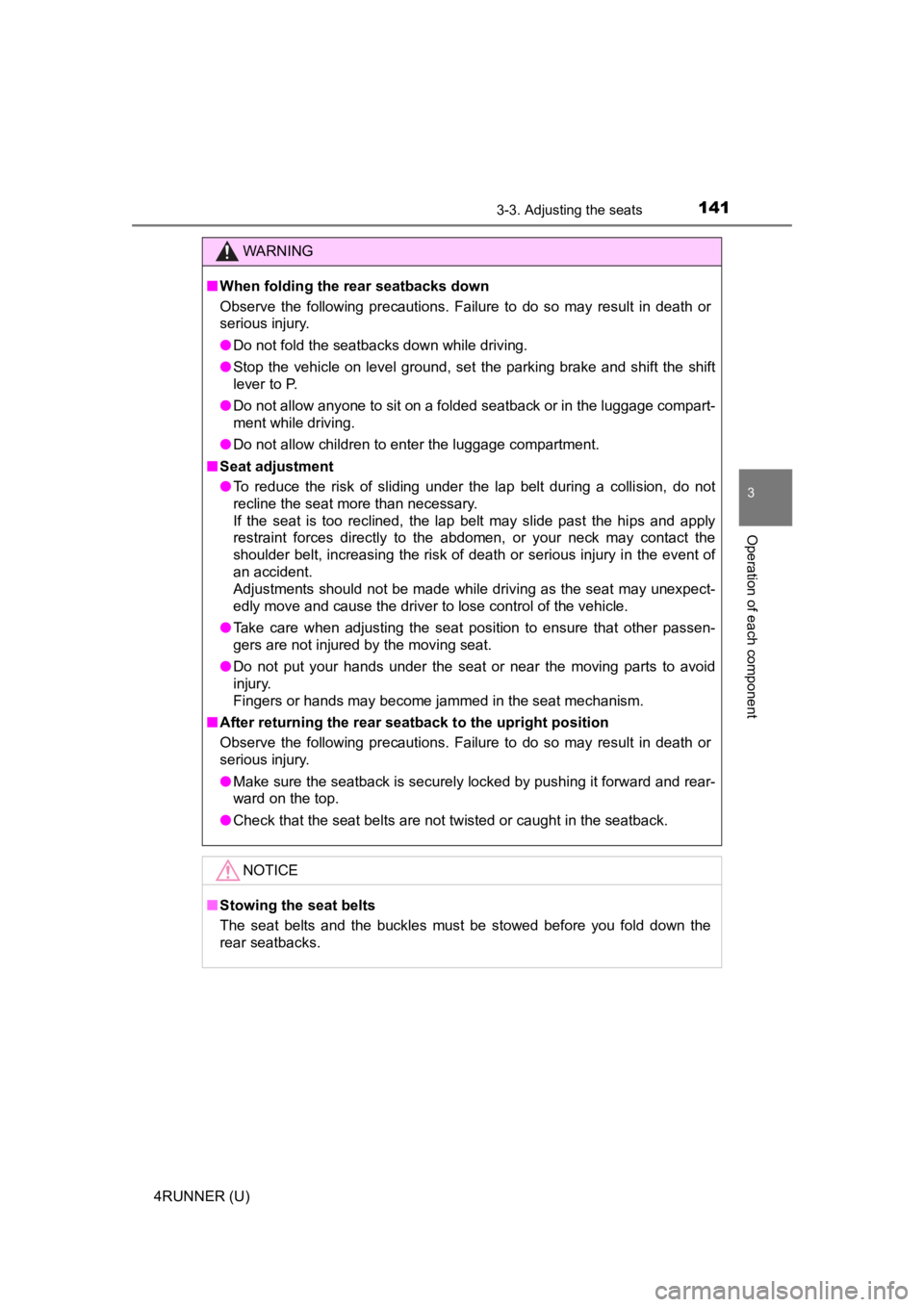
1413-3. Adjusting the seats
3
Operation of each component
4RUNNER (U)
WARNING
■When folding the rear seatbacks down
Observe the following precautions. Failure to do so may result in death or
serious injury.
● Do not fold the seatbacks down while driving.
● Stop the vehicle on level ground, set the parking brake and shi ft the shift
lever to P.
● Do not allow anyone to sit on a folded seatback or in the luggage compart-
ment while driving.
● Do not allow children to enter the luggage compartment.
■ Seat adjustment
● To reduce the risk of sliding under the lap belt during a collision, do not
recline the seat more than necessary.
If the seat is too reclined, the lap belt may slide past the hips and apply
restraint forces directly to the abdomen, or your neck may contact the
shoulder belt, increasing the risk of death or serious injury i n the event of
an accident.
Adjustments should not be made while driving as the seat may un expect-
edly move and cause the driver to lose control of the vehicle.
● Take care when adjusting the seat position to ensure that other passen-
gers are not injured by the moving seat.
● Do not put your hands under the seat or near the moving parts to avoid
injury.
Fingers or hands may become jammed in the seat mechanism.
■ After returning the rear seatback to the upright position
Observe the following precautions. Failure to do so may result in death or
serious injury.
● Make sure the seatback is securely locked by pushing it forward and rear-
ward on the top.
● Check that the seat belts are not twisted or caught in the seatback.
NOTICE
■Stowing the seat belts
The seat belts and the buckles must be stowed before you fold down the
rear seatbacks.
Page 155 of 608
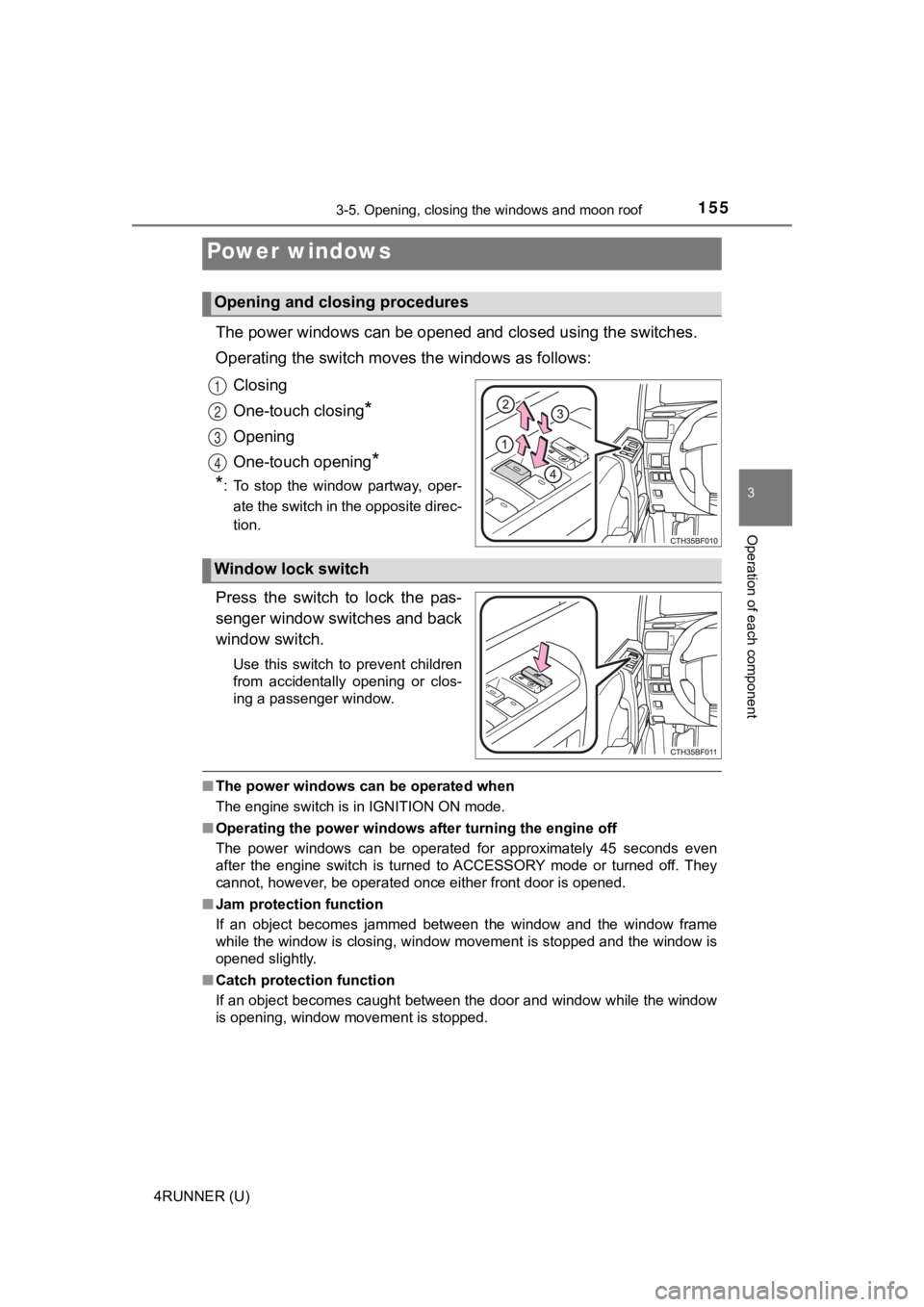
155
3
Operation of each component
4RUNNER (U)
3-5. Opening, closing the windows and moon roof
The power windows can be opened and closed using the switches.
Operating the switch moves the windows as follows:
Closing
One-touch closing
*
Opening
One-touch opening
*
*
: To stop the window partway, oper-
ate the switch in the opposite direc-
tion.
Press the switch to lock the pas-
senger window switches and back
window switch.
Use this switch to prevent children
from accidentally opening or clos-
ing a passenger window.
■ The power windows can be operated when
The engine switch is in IGNITION ON mode.
■ Operating the power windows after turning the engine off
The power windows can be operated for approximately 45 seconds even
after the engine switch is turned to ACCESSORY mode or turned o ff. They
cannot, however, be operated once either front door is opened.
■ Jam protection function
If an object becomes jammed between the window and the window f rame
while the window is closing, window movement is stopped and the window is
opened slightly.
■ Catch protection function
If an object becomes caught between the door and window while the window
is opening, window movement is stopped.
Power windows
Opening and closing procedures
1
2
3
4
Window lock switch
Page 157 of 608
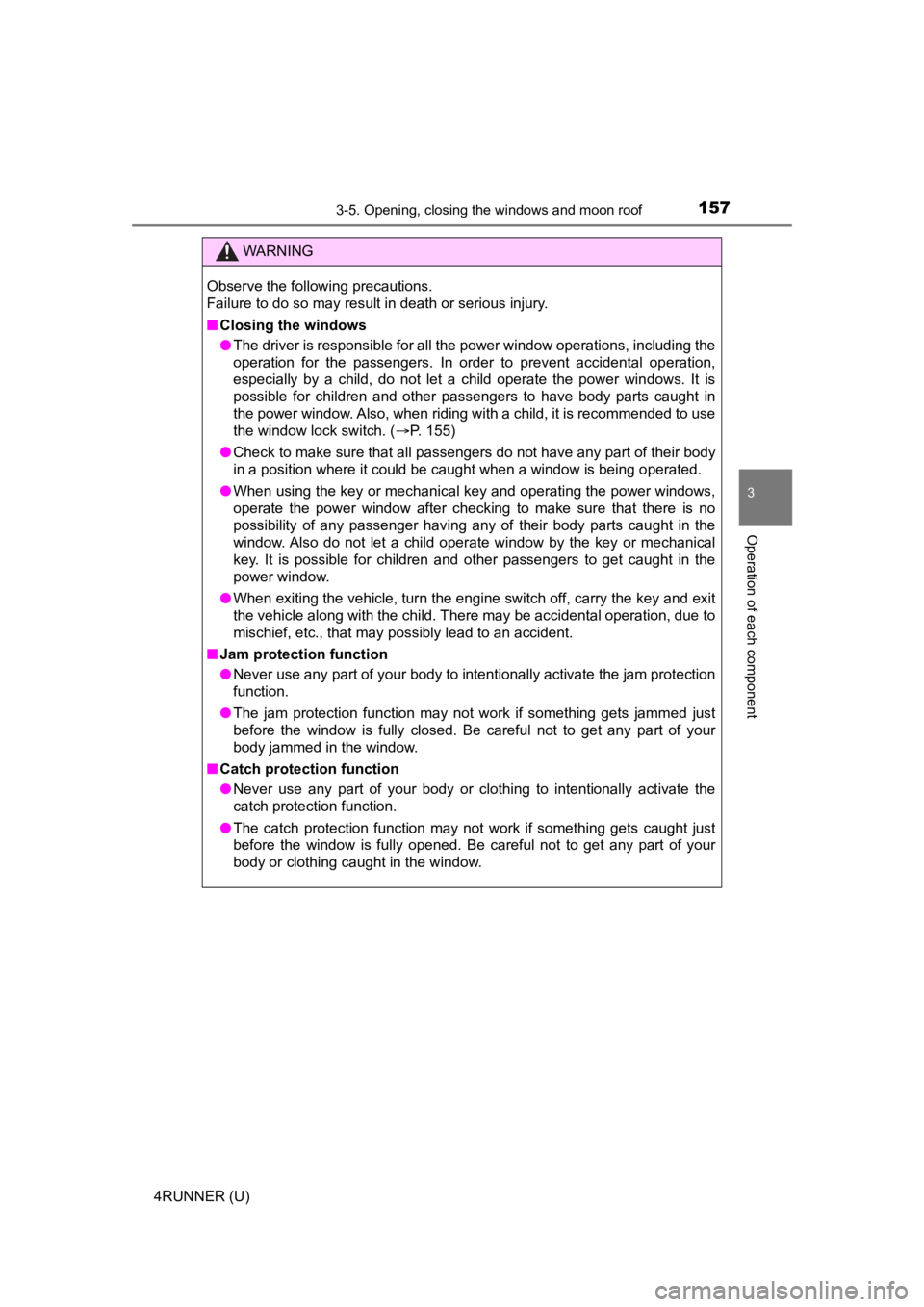
1573-5. Opening, closing the windows and moon roof
3
Operation of each component
4RUNNER (U)
WARNING
Observe the following precautions.
Failure to do so may result in death or serious injury.
■Closing the windows
● The driver is responsible for all the power window operations, including the
operation for the passengers. In order to prevent accidental op eration,
especially by a child, do not let a child operate the power windows. It is
possible for children and other passengers to have body parts c aught in
the power window. Also, when riding with a child, it is recommended to use
the window lock switch. ( P. 155)
● Check to make sure that all passengers do not have any part of their body
in a position where it could be caught when a window is being o perated.
● When using the key or mechanical key and operating the power wi ndows,
operate the power window after checking to make sure that there is no
possibility of any passenger having any of their body parts cau ght in the
window. Also do not let a child operate window by the key or me chanical
key. It is possible for children and other passengers to get caught in the
power window.
● When exiting the vehicle, turn the engine switch off, carry the key and exit
the vehicle along with the child. There may be accidental operation, due to
mischief, etc., that may possibly lead to an accident.
■ Jam protection function
● Never use any part of your body to intentionally activate the jam protection
function.
● The jam protection function may not work if something gets jammed just
before the window is fully closed. Be careful not to get any pa rt of your
body jammed in the window.
■ Catch protection function
● Never use any part of your body or clothing to intentionally ac tivate the
catch protection function.
● The catch protection function may not work if something gets caught just
before the window is fully opened. Be careful not to get any part of your
body or clothing caught in the window.
Page 423 of 608
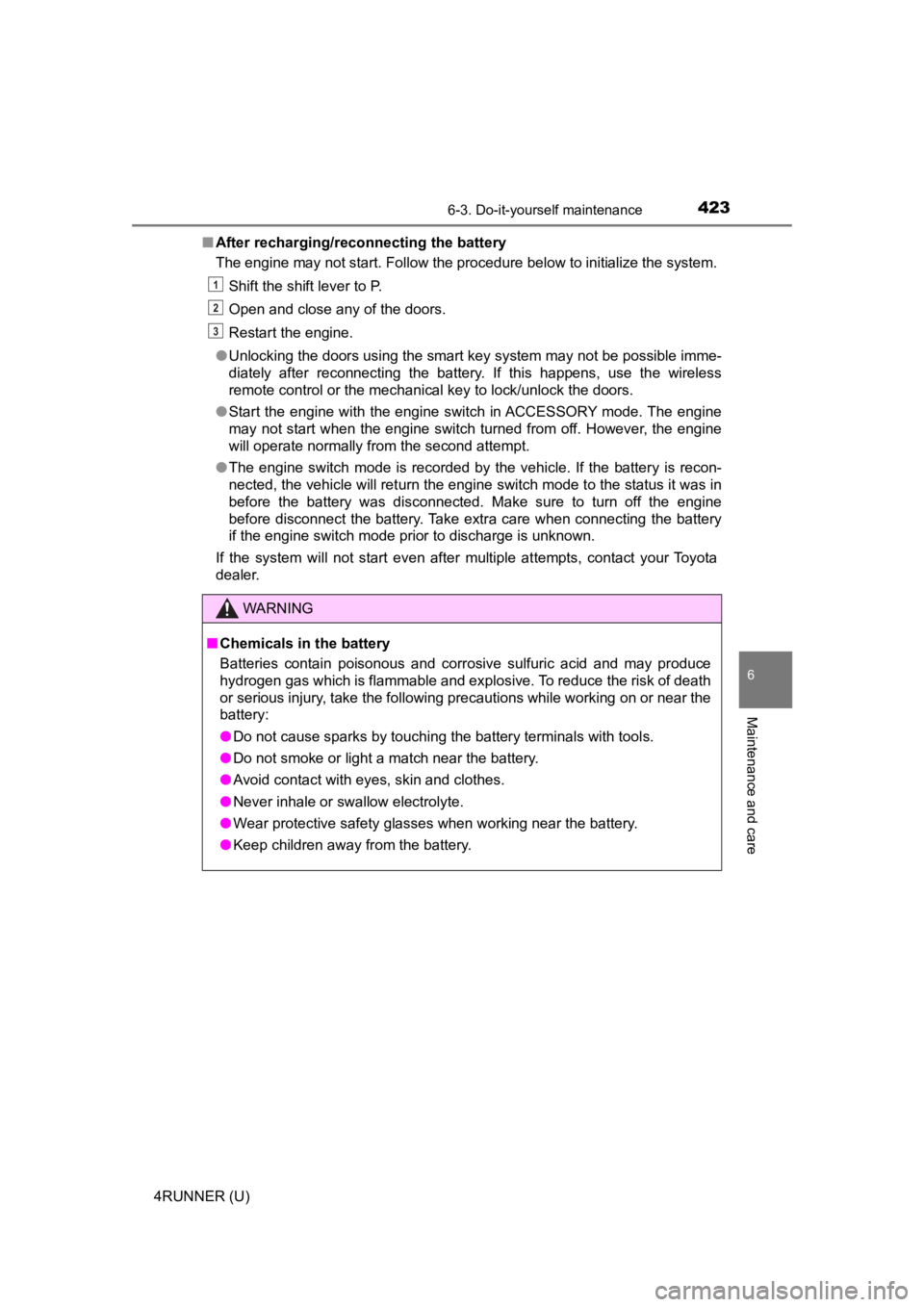
4236-3. Do-it-yourself maintenance
6
Maintenance and care
4RUNNER (U)■
After recharging/reco nnecting the battery
The engine may not start. Follow the procedure below to initialize the system.
Shift the shift lever to P.
Open and close any of the doors.
Restart the engine.
● Unlocking the doors using the smart key system may not be possible imme-
diately after reconnecting the battery. If this happens, use the wireless
remote control or the mechanical key to lock/unlock the doors.
● Start the engine with the engine switch in ACCESSORY mode. The engine
may not start when the engine switch turned from off. However, the engine
will operate normally from the second attempt.
● The engine switch mode is recorded by the vehicle. If the battery is recon-
nected, the vehicle will return the engine switch mode to the s tatus it was in
before the battery was disconnected. Make sure to turn off the engine
before disconnect the battery. Take extra care when connecting the battery
if the engine switch mode prior to discharge is unknown.
If the system will not start even after multiple attempts, contact your Toyota
dealer.
WARNING
■ Chemicals in the battery
Batteries contain poisonous and corrosive sulfuric acid and may produce
hydrogen gas which is flammable and explosive. To reduce the ri sk of death
or serious injury, take the following precautions while working on or near the
battery:
● Do not cause sparks by touching the battery terminals with tools.
● Do not smoke or light a match near the battery.
● Avoid contact with eyes, skin and clothes.
● Never inhale or swallow electrolyte.
● Wear protective safety glasses when working near the battery.
● Keep children away from the battery.
1
2
3
Page 448 of 608
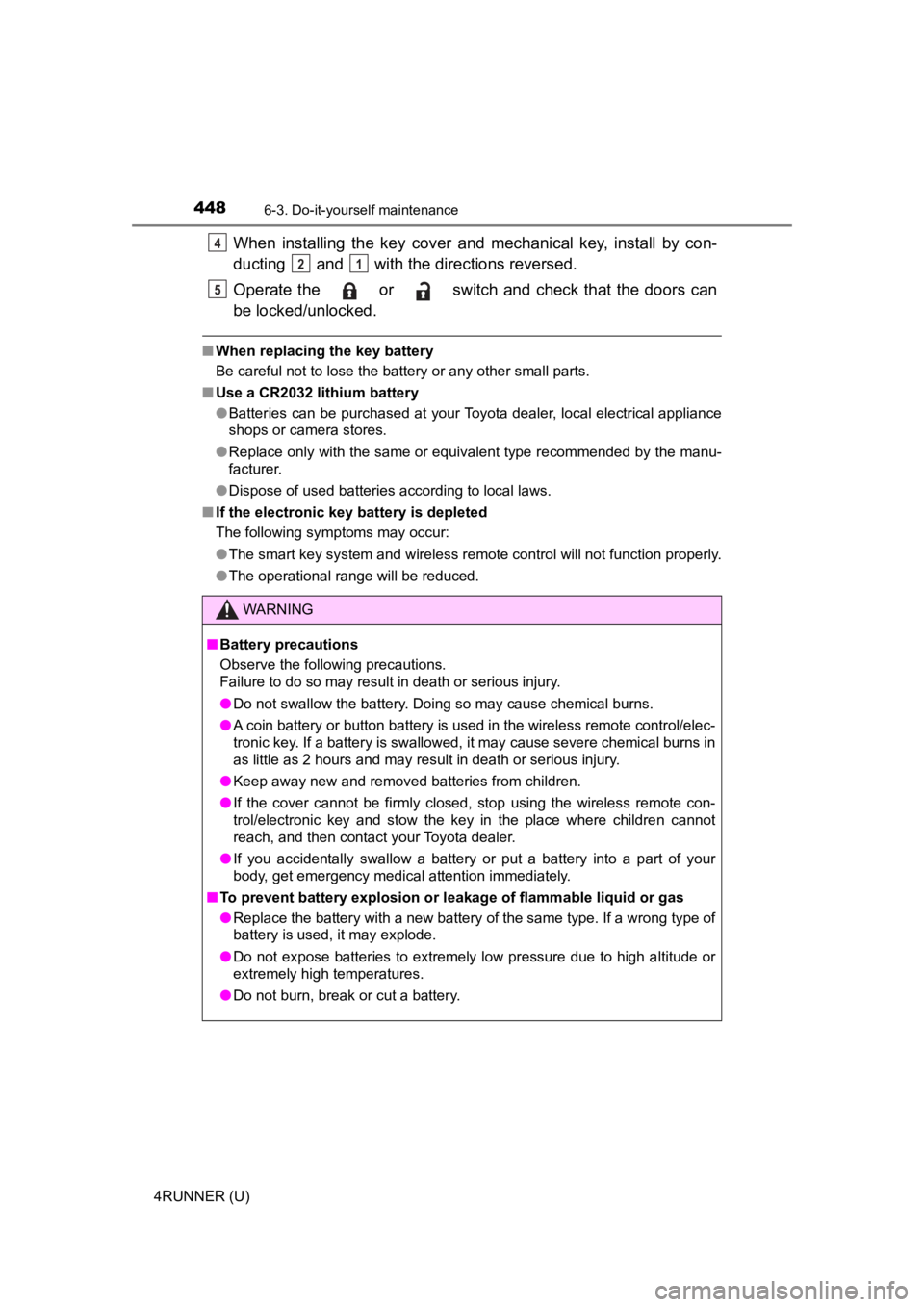
4486-3. Do-it-yourself maintenance
4RUNNER (U)
When installing the key cover and mechanical key, install by con-
ducting and with the directions reversed.
Operate the or switch and check that the doors can
be locked/unlocked.
■When replacing the key battery
Be careful not to lose the battery or any other small parts.
■ Use a CR2032 lithium battery
●Batteries can be purchased at your Toyota dealer, local electrical appliance
shops or camera stores.
● Replace only with the same or equivalent type recommended by the manu-
facturer.
● Dispose of used batteries according to local laws.
■ If the electronic key battery is depleted
The following symptoms may occur:
●The smart key system and wireless remote control will not funct ion properly.
● The operational range will be reduced.
WARNING
■ Battery precautions
Observe the following precautions.
Failure to do so may result in death or serious injury.
● Do not swallow the battery. Doing so may cause chemical burns.
● A coin battery or button battery is used in the wireless remote control/elec-
tronic key. If a battery is swallowed, it may cause severe chem ical burns in
as little as 2 hours and may result in death or serious injury.
● Keep away new and removed batteries from children.
● If the cover cannot be firmly closed, stop using the wireless r emote con-
trol/electronic key and stow the key in the place where childre n cannot
reach, and then contact your Toyota dealer.
● If you accidentally swallow a battery or put a battery into a part of your
body, get emergency medical attention immediately.
■ To prevent battery explosion or leakage of flammable liquid or gas
● Replace the battery with a new battery of the same type. If a w rong type of
battery is used, it may explode.
● Do not expose batteries to extremely low pressure due to high altitude or
extremely high temperatures.
● Do not burn, break or cut a battery.
4
21
5
Page 578 of 608

578
4RUNNER (U)
What to do if... (Troubleshooting)
What to do if... (Troubleshooting)
●If you lose your keys or mechanical keys, new genuine mechanical keys
can be made by your Toyota dealer. ( P. 103)
●If you lose your keys or electronic keys, the risk of vehicle t heft increases
significantly. Contact your Toyota dealer immediately. ( P. 105)
●Is the key battery weak or depleted? (P. 447)
●Is the engine switch in IGNITION ON mode?
When locking the doors, turn the engine switch off. ( P. 200)
●Is the electronic key left inside the vehicle?
When locking the doors, make sure that you have the electronic key on
your person.
●The function may not operate properly due to the condition of t he radio
wave. ( P. 117)
●Is the child-protector lock set?
The rear door cannot be opened from inside the vehicle when the lock is
set. Open the rear door from outside and then unlock the child-protector
lock. ( P. 109)
If you have a problem, check the following before contacting
your Toyota dealer.
The doors cannot be locked, unlocked, opened or closed
You lose your keys
The doors cannot be locked or unlocked
The rear door cannot be opened
Page 582 of 608

582
4RUNNER (U)
Alphabetical index
Alphabetical index
A/C .................................... 342, 349Air conditioning filter ............. 445
ABS (Anti-lock Brake System)...... 322
Function ................................ 322
Warning light ......................... 478
Active head restraints ............. 130
Active traction control ............ 302
Air conditioning filter .............. 445
Air conditioning
system ............................ 342, 349 Air conditioning filter ............. 445
Airbags ....................................... 37
Airbag operating conditions .... 44
Airbag precautions for your child ......................... 39
Airbag warning light .............. 478
Correct driving posture ........... 30
Curtain shield airbag operating conditions ............. 44
Curtain shield airbag precautions ........................... 41
Front passenger occupant classification syst em............. 48
General airbag precautions .... 39
Locations of airbags................ 37
Modification and disposal of airbags.............................. 43
Side airbag operating
conditions ............................. 44
Side airbag precautions .......... 39
Side and curtain shield airbags operating conditions ............. 44
Side and curtain shield airbags precautions .............. 39
SRS airbags............................ 37 Alarm .......................................... 79
Alarm ...................................... 79
Warning buzzer .................... 477
Anchor brackets ........................ 59
Antennas (smart key system) ............... 113
Anti-lock Brake System (ABS) ...................................... 322
Function ................................ 322
Warning light......................... 478
Armrest..................................... 386
Assist grip ................................ 386
Audio system
*
AUTO LSD system................... 304
Automatic air conditioning
system.................................... 349
Automatic High Beam ............. 217
Automatic light control
system.................................... 212
Automatic running boards ..... 121
Automatic transmission ......... 205
If the shift lever cannot be shifted from P .... 208
S mode ................................. 206
AUX port
*
Auxiliary boxes ........................ 367
A
Page 583 of 608
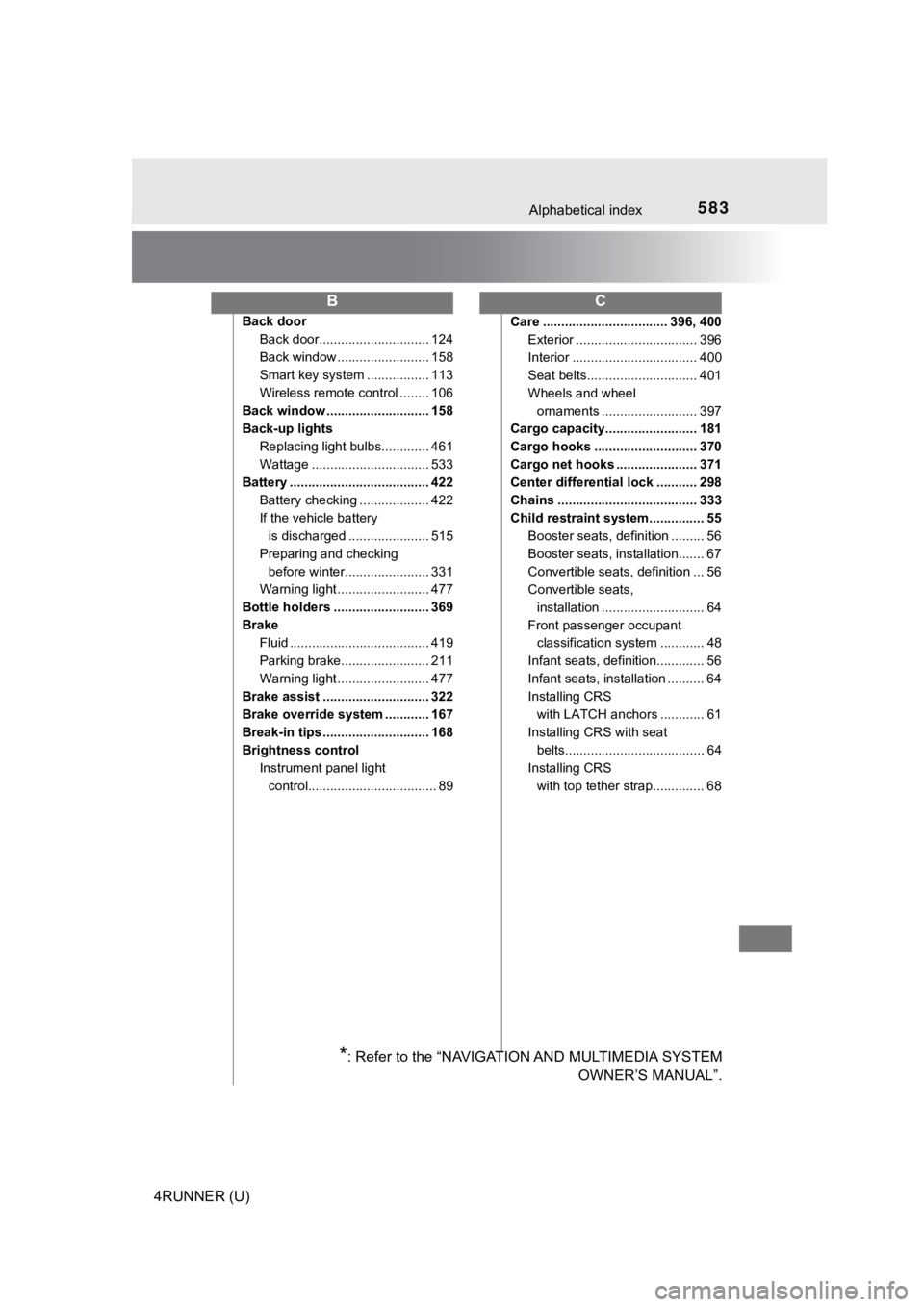
583Alphabetical index
4RUNNER (U)
Back doorBack door.............................. 124
Back window ......................... 158
Smart key system ................. 113
Wireless remote control ........ 106
Back window ............................ 158
Back-up lights Replacing light bulbs............. 461
Wattage ................................ 533
Battery ...................................... 422
Battery checking ................... 422
If the vehicle battery is discharged ...................... 515
Preparing and checking before winter....................... 331
Warning light ......................... 477
Bottle holders .......................... 369
Brake Fluid ...................................... 419
Parking brake........................ 211
Warning light ......................... 477
Brake assist ............................. 322
Brake override system ............ 167
Break-in tips ............................. 168
Brightness control Instrument panel light
control................................... 89 Care .................................. 396, 400
Exterior ................................. 396
Interior .................................. 400
Seat belts.............................. 401
Wheels and wheel ornaments .......................... 397
Cargo capacity......................... 181
Cargo hooks ............................ 370
Cargo net hooks ...................... 371
Center differential lock ........... 298
Chains ...................................... 333
Child restraint system............... 55 Booster seats, definition ......... 56
Booster seats, installation....... 67
Convertible seats, definition ... 56
Convertible seats,
installation ............................ 64
Front passenger occupant classification syst em ............ 48
Infant seats, definition............. 56
Infant seats, installation .......... 64
Installing CRS with LATCH anchors ............ 61
Installing CRS with seat belts...................................... 64
Installing CRS
with top tether strap.............. 68
BC
*: Refer to the “NAVIGATION AND MULTIMEDIA SYSTEM OWNER’S MANUAL”.